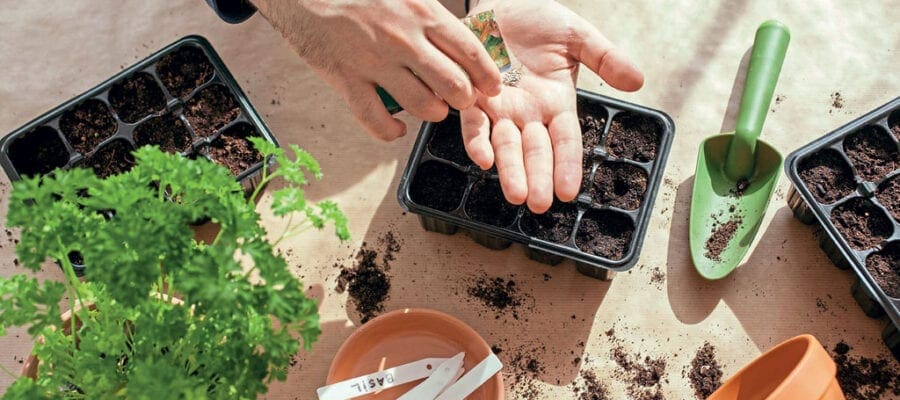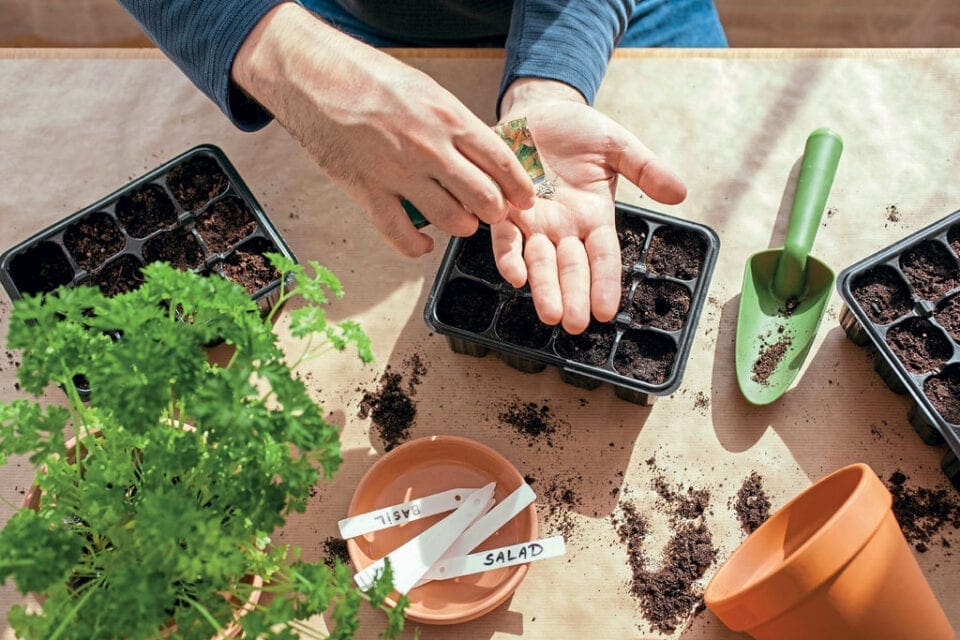
Here are some common questions we get asked about sowing seeds.
Sowing Undercover
Tender crops such as tomatoes, peppers, squashes, French and runner beans are often started in pots or cell trays under cover. Here are some queries relating to indoor sowings.
Q: Should old pots and sowing trays be washed before using?
A: It is beneficial to have clean pots and trays, especially for sowing, to reduce the risk of diseases affecting the seedlings (see damping off).
You can buy a cleaning solution called Citrox which is ideal for pots and also cleaning greenhouses. It is a citrus based cleanser and does not harm plant material. If you use other cleaning products it is best to rinse the pots before using.
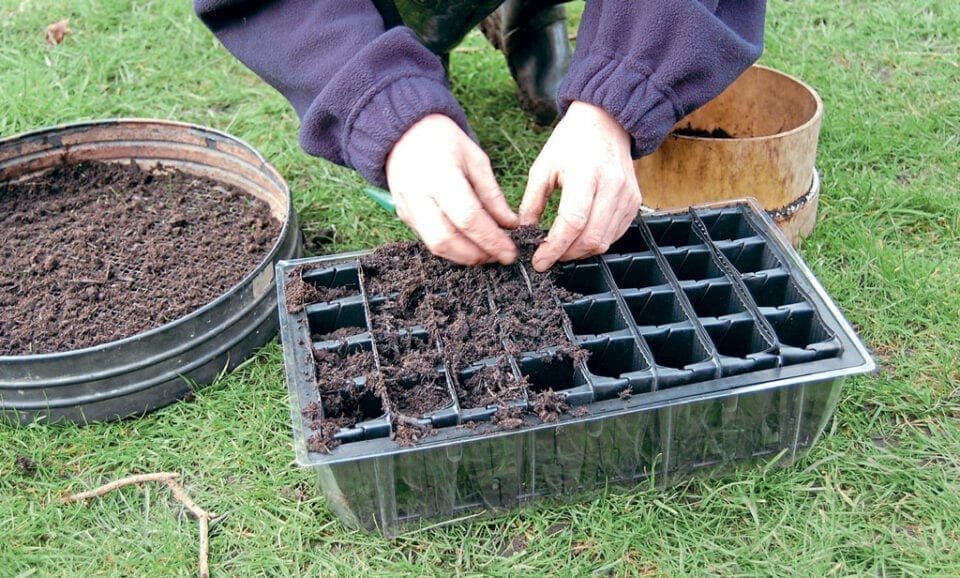
Q: What is the difference between pots, cell trays and seed trays?
A: Small pots (9cm/3½in) are ideal for starting off large seeded crops such as courgette and squashes, and are also good for potting on a single pepper or tomato seedling.
Cell trays are good for veg. These are trays of individual cells. Tiny cells are great for things like lettuce and leeks. Larger cell trays – say six large cells in a tray – are equivalent to your small 9cm (3½in) pots and ideal for sowing individual large seeded crops such as courgettes and other squashes.
Rootrainers are a bit like cell trays but they are a unique design, having four deep cells that are hinged and can open out like a book, making it easier to remove root ball.
Seed trays pre-date moulded plastic cell trays and were always the traditional way to start off veg. Originally made of wood, in recent years plastic has taken over, which is easier to clean and reuse, but wooden ones are making a comeback.
They are fine as long as you can space the seeds well so you can prick them out easily. The roots tend to get more tangled in these, hence cell trays being such a great innovation for veg growing.
Q: Do I need to feed seedlings?
A: Usually they are potted into larger pots and fresh compost before you need to feed them. The exception are seedlings that are kept ticking over in cell trays. They can often stay longer in these and so a weekly feed of a proprietary general liquid feed is ideal.
Q: What is meant by a cold/warm greenhouse?
A: You may have heard the term growing crops in a ‘cold greenhouse’. This simply means there is not an artificial heat source installed; only the natural heat from the sun.
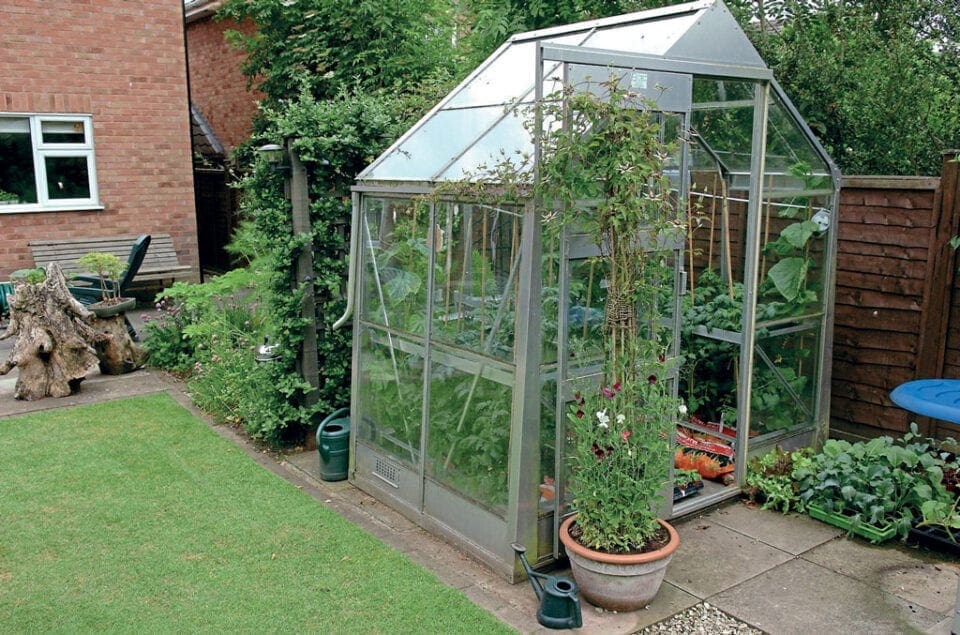
Q: What is damping off?
A: This is a problem that can occur from time to time. You will notice seedlings suddenly collapsing. You may spot low down the stems have rotted and they just keel over.
You can have a tray of seedlings and just a section of the seedlings will be affected. Overwatering can make this more prevalent as can using unsterilized soil or dirty pots.
Q: Do I need a propagator?
A: Most veg seeds don’t actually need a propagator. A few will certainly benefit, such as peppers and tomatoes, but if you have a warm windowsill it will usually suffice for most veg. You could place the pots in a plastic bag to give a bit more protection too.
If you want to start off seeds in a cold greenhouse in early spring then a heated propagator or heated bench would be needed, especially for the germination of subjects like peppers, aubergines and tomatoes. One really vital thing to remember is to check daily, and often twice daily.
As soon as you see the soil start to crack open and a flash of green, remove the pots from the heat and place in a slightly cooler place than the propagator, such as a bright windowsill.
Just hours of delay at this stage could result in elongated, weak seedlings. If you do get elongated seedlings they can be planted deeper in their next pots or cell trays.
Q: What is pricking out?
A: This is lifting seedlings and moving them into either their own pot or maybe into a larger cell tray. You do this because lots of seedlings in a pot or a seed tray will eventually get crowded, and will elongate and weaken or run out of nutrients. It is usually done when they are still small so they are less affected by the move.
When they germinate you will see the simple seed leaves first, then the true leaves form. As soon as the first of these has started to unfurl, it is a good time to prick the seedlings out.
Traditionally, seeds were always sown in seed trays and you ended up with a mass of seedlings that you then lifted individually (pricked out) and moved (transplanted) into individual pots or maybe spaced out in another seed tray to give them more room to grow.
Sowing in cell trays has the benefit that you can leave the seedlings a little longer before transplanting, especially if you give them a weekly feed of a general liquid fertiliser. When pricking out seedlings, always hold the seedling by its leaves not the stem.
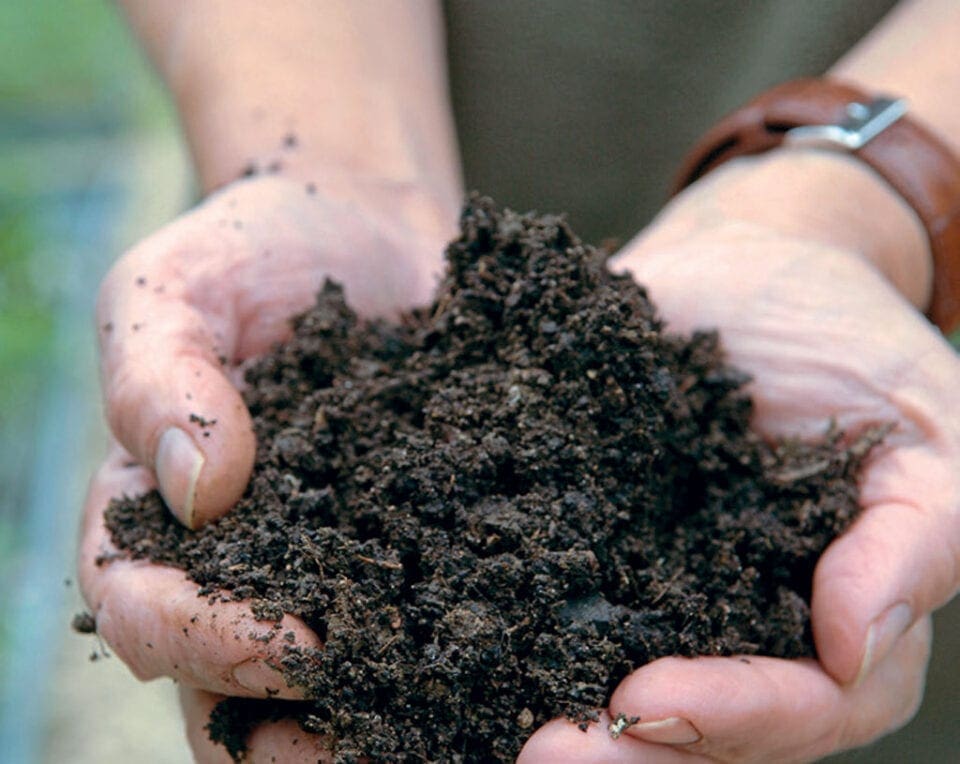
Q: Can I use ordinary soil in my pots when sowing tender crops like tomatoes?
A: In theory, yes, but there is a greater risk that with the warmer temperatures and moist conditions, fungal and bacterial diseases may affect the emerging seedlings.
Damping off could be more of a problem. Rather than use soil, use a proprietary seed or multi-purpose compost. These have been heat treated or made from inert materials and less likely to harbour harmful organisms.
John Innes seed compost is a loam (soil) based one. Peat-free multi-purpose composts are available. Read the bag, as some will actually say not suitable for sowing.
These may be composts more suited to mature plants and contain higher nutrients which can affect seed germination.
Q: What is hardening off?
A: Once seeds have germinated it is usual that the seedling will require slightly less heat and so this is the start of the hardening off process. In fact, they require decreasing amount of heat as they get larger.
As an example, a tomato seed may benefit from a temperature of 21C (70F) to germinate but then only about 18C (65F) as a seedling to grow on.
Once they are about 10cm (4in) they are able to cope with even cooler temperatures again. If you can reduce the temperatures gradually (harden off) then you don’t shock the plant, which can affect the growth.
Outdoor Sewing
Sowing direct onto your plot can start when the conditions are right for your area. It can vary considerably and from year to year. Experience will help with this but generally once you start to see weed seedlings emerge then the conditions are probably okay.
A soil temperature of about 5C (41F) is also a good guide. The general rule of thumb is southerly plots with the right aspect and soil could start sowings as early as March but for Midlands and northerly gardens it may be April or May before sowing can start direct in the ground.
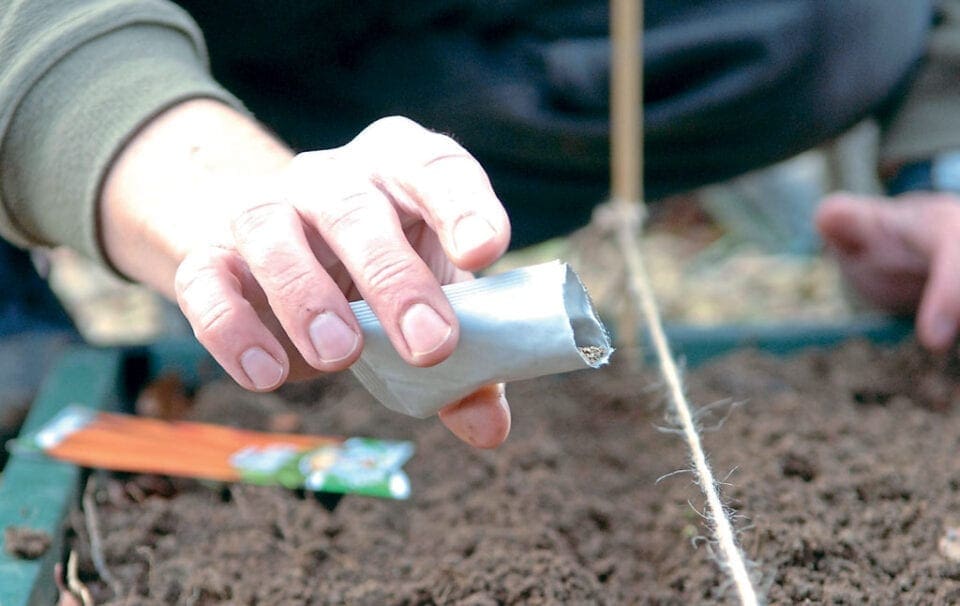
Q: What is a prepared seed bed?
A: Ideally you want a fine, crumbly surface (a fine tilth) to sow seeds into and a soil beneath that is not compacted.
If you don’t garden using the ‘no dig’ method or have raised beds, then you may find the soil gets compacted due to walking over it. Traditionally this type of plot is dug over in autumn or early spring. You then have to rake over the soil to create an even, crumbly texture with no big lumps.
Q: What is meant by a seed drill?
A: A seed drill is a groove in the soil into which you sow the seed. On the seed packet it will suggest a sowing depth and you make the drill roughly that depth.
Q: Do I need to sow in lines?
A: No, you don’t have to but for maximum crop yield straight lines have always been the traditional way. The advantage of sowing in a straight line is you can often distinguish weed seeds from the crop. Also maintaining crops is easier in straight lines.
Q: Do I water the soil before or after sowing?
A: It depends on your preference. Some gardeners will water after the seed is sown and covered with soil. Some dribble water into a seed drill first before sowing. This means the soil will definitely be nice and damp below the seed and it evens the sowing surface in the drill. Then, after sowing and covering with soil, a sprinkling of water using a fine rose on a watering can finishes the job and seals moisture all around the seed.
If the weather is dry a few days after sowing, then water the rows. Use a fine rose on a watering can so you don’t disturb the soil too much. When there are seedlings to water, take a watering can with no rose on the end and aim the tip to the base of the seedling row and very gently trickle water along it. You direct it deep to the roots and you use less water.

Q: What is thinning out and how do I do it?
A: When the seedlings emerge there will often be too many close together, which will restrict their growth. On the seed packet it may suggest a final spacing for the plants.
Initially, as soon as the seedlings can be handled you can pull out excess ones to leave a little gap of say 1-2cm (¼-½in) between seedlings. This allows for space to grow but also allows for some losses.
When they get a bit bigger and more robust you can thin again to leave more room between the seedlings and maybe the final spacing distance.
Q: What is meant by sowing thinly?
A: Most veg seed is so small that to take one seed at a time and sow it at the exact final spacing would be difficult. Also, not a good idea as some of the seed will not germinate or be eaten by pests.
You may have heard the expression ‘one for the mouse, one for the crow, one to rot, one to grow’ – so you always want a few extra in the row. However, there is a balance. You don’t want a very dense row of seedlings because these can be difficult to thin out. It is finding that happy medium.

